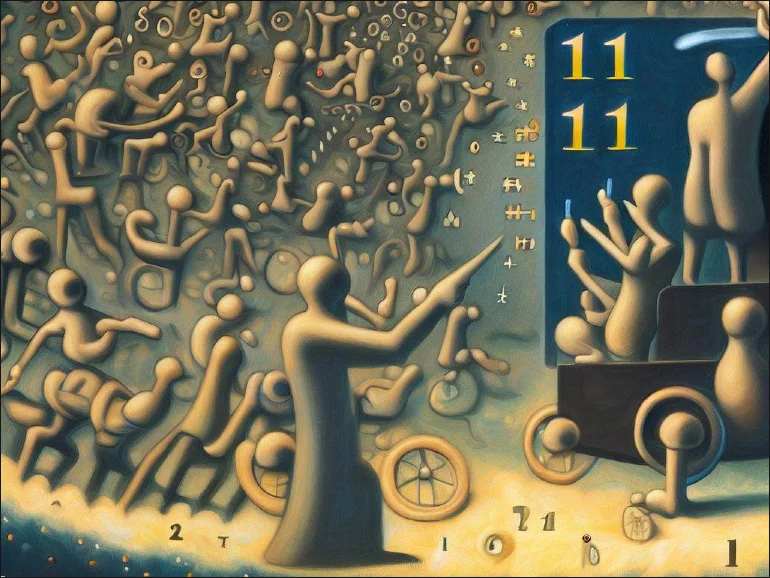Indulge me, for a moment, and imagine you’re on an intriguing quest to brew the perfect cup of tea. Now, it’s not just about the final soothing sip, but the entire journey that takes you there – selecting the right tea leaves, setting the perfect water temperature, ensuring the optimal steeping time, and more. Each step contributes significantly to your ultimate tea experience.
Surprisingly enough, a similar journey takes place in the realm of digital marketing through a process called Attribution Modeling. Much like brewing tea, where you can’t merely attribute the taste to the type of leaves or the temperature alone, in digital marketing, it is often tricky to pinpoint which initiative was responsible for a customer’s conversion.
Attribution modeling is a strategic framework used to assign credit to different touchpoints in a customer’s journey towards a conversion, such as a sale or an enquiry. This fascinating process lets marketers understand and appreciate the importance of each touchpoint – be it an engaging social media post, a well-placed ad, or an informative blog – in contributing to the final purchase decision.
With this backdrop, let’s embark on an exploration of attribution models across the lifecycle of the users who consume or products, services, and content. Ready to unravel this enigma? Let’s get brewing!
Last Click Attribution Model
First off, we’ve got the Last Click Attribution model. Picture this: you’ve got your piping hot cup of tea ready. That last sip, the one that leaves you satisfied, warm, and ready to face the day – that’s your last click. This model gives all the credit to that last sip, or in marketing terms, the last ad or keyword clicked on before the purchase. It’s like saying the entire value of your tea drinking experience comes from that final sip, ignoring the temperature, the steeping time, the quality of the tea leaves, and everything else that contributed to making that tea.

But, just like our tea analogy, there are downsides to this. By attributing all the credit to the last sip, you’re ignoring all the other factors that led to that point. The same applies to the Last Click model. It can oversimplify the customer journey, leaving out all the other touchpoints that might have influenced the decision to purchase. It’s a simple model, sure, but it might not give you the most accurate picture of your customer’s journey.
Pros of Last Click
- Simplicity: The Last Click Attribution model is easy to implement and understand. It attributes all the credit to the last interaction before a conversion, making it straightforward to track and analyze.
- Clear focus on the final touchpoint: By giving all the credit to the last click, this model emphasizes the immediate action that led to a conversion. It can be useful for understanding the impact of specific ads or keywords in the final stages of the customer journey.
- Direct measurement of conversion: With the Last Click model, it’s easy to measure the effectiveness of individual marketing campaigns or channels in driving conversions. This can help allocate resources and optimize marketing strategies accordingly.
Cons of Last Click
- Neglects earlier touchpoints: By solely attributing the credit to the last interaction, the Last Click model ignores all the other touchpoints that a customer may have encountered before making a purchase decision. This can lead to an incomplete understanding of the customer journey.
- Overemphasizes final interactions: The Last Click Attribution model may overvalue the last click and underestimate the impact of other touchpoints that contributed to the conversion. It fails to consider the influence of earlier brand exposure, research, or engagement that shaped the customer’s decision.
- Potential for missed opportunities: By ignoring earlier touchpoints, the Last Click Attribution model may overlook valuable marketing efforts that played a significant role in attracting and nurturing customers. It might hinder the identification of underperforming channels or campaigns that need optimization.
Time Decay Attribution Model
Next up, we’ve got the Time Decay Attribution model. Let’s compare this to the life of a guinea pig. These adorable creatures have a lifespan of about 4-8 years, but every guinea pig owner knows that the older they get, the more attached you become to them. Each day spent with them is more valuable than the last.

Time Decay is similar to this. This model assigns more credit to the touchpoints that are closer to the date of final conversion. It’s like saying the most recent days with your guinea pig (or customer) are the most valuable. The Time Decay model operates with a 7-day half-life, meaning an interaction a week ago is half as valuable as one today. This is a useful model if your customers tend to take a while to make the decision to purchase.
However, like our guinea pig analogy, the Time Decay model can overvalue recent interactions. Just because you cherish the recent memories with your guinea pig doesn’t mean the earlier days weren’t important. Similarly, earlier touchpoints in the customer journey can still be significant, even if they’re not given as much credit in the Time Decay model.
Pros of Time Decay
- Reflects the influence of recency: The Time Decay Attribution model acknowledges that recent touchpoints have a greater impact on the conversion decision. It recognizes that customers may be more influenced by recent interactions and adjusts the credit allocation accordingly.
- Suitable for longer customer journeys: If your customers typically have a longer decision-making process, the Time Decay model can be beneficial. It ensures that touchpoints closer to the conversion date are given more weight, capturing the effect of interactions that occurred in the final stages of the customer journey.
- Aligns with customer behavior patterns: This model considers the natural tendency for people to be more influenced by recent experiences. It resonates with the common cognitive bias known as the “recency effect,” where individuals place more importance on recent events or information.
Cons of Time Decay
- Neglects early touchpoints: Just as the Time Decay model emphasizes recent interactions, it undervalues touchpoints that occurred earlier in the customer journey. This can result in a skewed understanding of the effectiveness of marketing efforts and fail to account for the impact of initial brand exposure and awareness.
- Ignores cumulative effect: By focusing primarily on recent touchpoints, the Time Decay model disregards the cumulative effect of multiple interactions over time. It may not adequately capture the full influence of earlier touchpoints that played a crucial role in shaping the customer’s decision-making process.
- Arbitrary time decay factor: The Time Decay model assumes a fixed time decay factor, such as a 7-day half-life. However, this decay factor may not accurately reflect the actual decay rate of influence for different touchpoints or industries. The chosen time decay factor may not align with the specific dynamics of your customers’ behavior.
Linear Attribution Model
On to the Linear Attribution Model. This one is like making an apple pie with the sweetest and most delicious Tassie apples. Every step is equally important, from picking the best apples (did I mention they should be from Tassie?), to making the crust, to baking it just right. If any step fails, the pie won’t turn out well (especially the bit about the apples being from Tasmania).

In the Linear model, all stages and touchpoints on the path to conversion receive equal credit. Each ad clicked, each website visited, each keyword searched – they’re all equally important in the customer’s journey to purchase. This model is great for getting a holistic view of the customer journey, as it doesn’t place more value on one touchpoint over another.
However, just like in our (Tassie) apple pie scenario, not every step is always equally important. Sometimes, certain steps or touchpoints can have a bigger impact on the customer’s decision to purchase. The Linear model doesn’t account for this, which can be a downside if your customer’s journey has clear key touchpoints.
Pros of Linear
- Holistic view of the customer journey: By giving equal importance to all touchpoints, the Linear model offers a comprehensive understanding of the customer journey. It considers the cumulative impact of multiple interactions, providing insights into the various stages and channels that influenced the conversion decision.
- Encourages optimization across all touchpoints: Since all touchpoints receive equal credit, the Linear model encourages marketers to optimize their strategies across the entire customer journey. It promotes a balanced approach to improving the effectiveness of marketing efforts at each stage, rather than focusing on specific touchpoints.
- Suitable for complex customer journeys: The Linear Attribution model is well-suited for customer journeys that involve multiple touchpoints and interactions. It accommodates situations where the path to conversion is not linear or where customers may engage with various channels before making a purchase decision.
Cons of Linear
- Lack of differentiation: The Linear model treats every touchpoint equally, regardless of their actual impact on the conversion decision. It fails to distinguish between more influential touchpoints and those with lesser significance, potentially obscuring insights into the most effective marketing efforts.
- Oversimplification of customer behavior: By assuming equal importance for all touchpoints, the Linear model oversimplifies the complexity of customer behavior. It may not accurately reflect the actual influence of specific touchpoints or interactions that played a critical role in driving the conversion.
- Ignoring non-linear paths: The Linear model assumes that the customer journey follows a linear progression, disregarding non-linear paths or decision-making processes. It may overlook instances where certain touchpoints had a disproportionate impact on the conversion and fail to capture their true significance (a display ad or video might have more significance than a text ad, or visa versa, for instance).
U-Shaped Attribution Model
Next, we have the U-Shaped or Position-Based Attribution model. This one is a bit like feeding your guinea pig. The first and last feed of the day are super important – they’re when you’re filling the food bowl and when you’re making sure it’s all been eaten. But the snacks and cuddles in between are important too.

In the U-Shaped model, 40% of the credit goes to the first and last touchpoint, and the remaining 20% is spread across the other interactions on the customer’s journey. This is great for if you believe the initial and final interactions are most important, but still want to account for the other touchpoints.
However, just like with feeding your guinea pig, the U-Shaped model can overvalue the first and last interactions. Maybe your guinea pig actually prefers the midday snacks (like pea flakes or sweet corn), or maybe a customer was more influenced by a touchpoint in the middle of their journey. This model might not capture that.
Pros of U-Shaped
- Recognition of initial and final touchpoints: The U-Shaped Attribution model allocates a significant portion of the credit (40%) to the first and last touchpoints in the customer journey. It acknowledges the importance of these interactions and gives them appropriate weight in the attribution process.
- Balanced consideration of other touchpoints: While the first and last touchpoints receive more credit, the U-Shaped model still allocates 20% of the credit to the other interactions in the middle. This ensures that the contributions of these touchpoints are not completely ignored and provides a more balanced representation of the customer journey.
- Allows for some flexibility: The U-Shaped model provides a certain degree of flexibility in attributing credit. It acknowledges that different touchpoints can have varying levels of influence and allows for customization by assigning specific weights to the first, last, and middle interactions.
Cons of U-Shaped
- Potential overemphasis on first and last touchpoints: While the U-Shaped model recognizes the importance of the first and last interactions, it may overvalue their impact by allocating a significant portion of the credit to these touchpoints. This may lead to an imbalance in credit distribution and overlook influential touchpoints in the middle of the customer journey.
- Lack of customization: Although the U-Shaped model allows for customization by assigning weights to different touchpoints, it may not provide enough granularity to capture the unique dynamics of every customer journey. It follows a fixed 40-20-40 split, which may not align with the specific nuances of your business or industry.
- Potential for overlooking influential mid-journey touchpoints: The U-Shaped model’s emphasis on the first and last touchpoints may overshadow the potential impact of influential interactions in the middle of the customer journey. It may not fully capture the customer’s decision-making process and fail to attribute credit accurately to touchpoints that played a significant role.
First Click Attribution Model
Finally, we have the First Click Attribution model. This one’s like the moment you find the perfect tea leaves for your cup of tea. You might try a few different types, but once you find ‘The One’, everything else falls into place. It almost doesn’t matter what the temperature of your water is, or that you are using unadulterated Tasmanian rain when your tea is that good.

In the First Click model, all the credit goes to the first ad clicked/viewed or keyword searched on the customer’s journey. It’s like saying the entire tea drinking experience comes from finding the perfect tea leaves.
But just like the Last Click attribution model, the First Click model can oversimplify the customer journey. Just because you found the perfect tea leaves doesn’t mean the water temperature, steeping time, and everything else doesn’t matter. Similarly, just because the customer clicked on a certain ad first doesn’t mean the other touchpoints weren’t important.
Pros of First Click
- Highlights the starting point of customer engagement: By assigning all the credit to the first touchpoint, the First Click model emphasizes the importance of the initial customer engagement. It recognizes that the first interaction can have a significant influence on shaping the customer’s perception and decision-making process.
- Useful for understanding customer acquisition: This model is particularly helpful for tracking and analyzing customer acquisition efforts. It provides insights into the effectiveness of the marketing campaigns, channels, or keywords that initially attracted customers and led them to engage with the brand.
Cons of First Click
- Neglects the impact of subsequent touchpoints: By attributing all the credit to the first touchpoint, the First Click model overlooks the potential impact of subsequent interactions on the customer journey. It fails to account for the cumulative effect of touchpoints that may have played a crucial role in driving the final conversion.
- Oversimplification of the customer journey: The First Click model oversimplifies the complexity of the customer journey by assigning all the credit to a single touchpoint. It disregards the influence of other touchpoints, such as mid-journey interactions or final touchpoints, which can provide valuable insights into the decision-making process.
When to Use Different Attribution Models
Let’s break down the customer journey into stages and discuss which attribution models are best suited for each stage. We spoke about making the perfect Tassie apple pie earlier – each stage of the process requires different tools and techniques, and understanding the customer journey and which attribution model to use to evacuate your effectiveness within it is no different.
During the Awareness stage, your goal is to introduce your brand, product, or service to potential customers. You’re trying to generate brand awareness and attract potential customers, just like displaying your fresh apples to passers-by. The First Click and U-Shaped Attribution Models can be useful here. The First Click model will tell you what first drew customers to your brand, while the U-Shaped model will also give credit to the final interaction, showing you what finally convinced them to convert.
In the Interest stage, you’re trying to capture the attention of potential customers and engage them with your content. You’re providing more information and resources, like offering apple pie samples and recipe cards. The Linear Attribution Model can be useful in this stage as it assigns equal credit to all touchpoints, helping you understand which content is effectively engaging your customers.
During the Consideration stage, you’re addressing customer needs and pain points, and demonstrating how your product or service meets their requirements. It’s like showing how your apple pie is made with high-quality ingredients and a tried-and-true recipe. The Time Decay Attribution Model can be effective here, as it gives more credit to touchpoints closer to the final conversion, helping you understand what information was most persuasive.
In the Intent stage, customers are showing readiness to move forward and expressing interest in purchasing. They’re taking actions indicating buying intent, like asking about your apple pie prices and sizes. Both the Last Click and U-Shaped Attribution Models can be effective in this stage. The Last Click model will show you the final touchpoint that pushed the customer to convert, while the U-Shaped model will also give credit to the initial interaction, showing you what first drew the customer in.
During the Evaluation/Purchase stage, customers are assessing pricing and options, comparing with competitors, and finalizing the purchase transaction. They’re deciding whether to buy your apple pie, or go for the cherry pie at the next stall. The Last Click Attribution Model is particularly useful here as it gives all the credit to the final touchpoint before the purchase, letting you know what convinced the customer to choose your product.
In the Post-Purchase stage, you’re providing customer support and assistance, ensuring customer satisfaction, and encouraging loyalty, repeat purchases, and referrals. It’s like offering pie care tips and asking for feedback. The Linear Attribution Model can be useful in this stage, as it gives equal credit to all touchpoints, helping you understand the full customer experience and identify areas for improvement.
Final Thoughts
Just as there are many paths to brewing the perfect cup of tea, caring for a guinea pig, or baking a Tassie apple pie, there are numerous ways to approach and understand a customer’s journey to undertake a goal action, such as a purchase or a form submission.
We’ve explored a variety of attribution models, each with its unique perspective. The Last Click model, akin to the final satisfying sip of tea, attributes all credit to the last interaction. The Time Decay model, like the increasing affection for a guinea pig over time, assigns more weight to recent touchpoints. The Linear model, much like the balanced process of making an apple pie, equally credits all touchpoints. The U-Shaped model, reminiscent of a guinea pig’s feeding schedule, emphasizes the first and last touchpoints, while the First Click model, like discovering the perfect tea leaves, gives all credit to the initial interaction.
However, to fully understand and apply these models, we have to consider them in the context of the customer’s journey. From the first touch, where potential customers become aware of a brand, to lead generation, where prospects become leads, and through to opportunity creation, conversion, and post-purchase interactions – each stage of the journey has its own unique needs and challenges.
So, whether you’re embarking on a quest to find the perfect tea, take care of a guinea pig, or bake a Tassie apple pie, remember to consider all the factors that contribute to the end result. The same holds true for understanding the customer journey – it’s about more than just the final action, it’s about every step along the way. Happy brewing, caring, baking, and, most importantly, learning about your customers!
